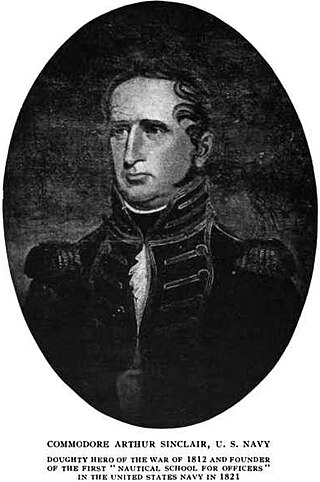
Commodore Arthur Sinclair was an early American naval hero, who served in the U.S. Navy during the Quasi-War with France, the First Barbary War and in the War of 1812. His three sons also served in the Navy; they resigned in 1861, however, to serve in the Confederate Navy.

The siege of Detroit, also known as the surrender of Detroit or the Battle of Fort Detroit, was an early engagement in the War of 1812. A British force under Major General Isaac Brock with indigenous allies under Shawnee leader Tecumseh used bluff and deception to intimidate U.S. Brigadier General William Hull into surrendering the fort and town of Detroit, Michigan, along with his dispirited army which actually outnumbered the victorious British and Indians.
The Battle of Longwoods took place during the Anglo-American War of 1812. On 4 March 1814, a mounted American raiding party defeated an attempt by British regulars, volunteers from the Canadian militia and Native Americans to intercept them near Wardsville, in present-day Southwest Middlesex, Ontario.

The Battle of Ogdensburg was a battle of the War of 1812. The British gained a victory over the Americans and captured the village of Ogdensburg, New York. Although small in scale, it removed the American threat to British supply lines for the remainder of the war.

Stormont, Dundas and Glengarry Highlanders is a Primary Reserve infantry regiment of the Canadian Army. It is part of 33 Canadian Brigade Group, 4th Canadian Division and is headquartered in Cornwall, Ontario.
The Bloody Assize in Upper Canada was a series of trials held at Ancaster during the War of 1812. The trials resulted in treason convictions and subsequent execution of Upper Canada residents who were found to have violently aided the enemy.
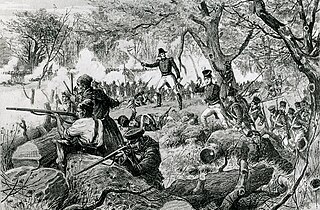
When the United States and the United Kingdom went to war against each other in 1812, the major land theatres of war were Upper Canada, Michigan Territory, Lower Canada and the Maritime Provinces of Nova Scotia, New Brunswick, Prince Edward Island and Cape Breton . Each of the separate British administrations formed regular and fencible units, and both full-time and part-time militia units, many of which played a major part in the fighting over the two and a half years of the war.
The Battle of Malcolm's Mills was the last battle of the War of 1812 fought in the Canadas. A force of American mounted troops overran and scattered a force of Canadian militia. The battle was fought on November 6, 1814, near the village of Oakland in Brant County, Upper Canada, and was part of a series of battles fought by American Brigadier General Duncan McArthur on an extended raid into Upper Canada, known variously as McArthur's Raid or Dudley's Raid. Marching over 200 miles (320 km) into Canada, the Americans returned to Detroit on November 17 after 11 days of raiding the Ontario Peninsula.

The Battle of Buffalo took place during the War of 1812 on December 30, 1813, in the State of New York, near the Niagara River. The British forces drove off the American defenders and destroyed many buildings and ships. The operation was retaliation for American troops burning the Canadian village of Newark.
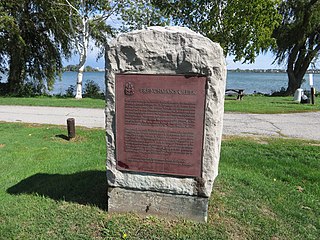
The Battle of Frenchman's Creek took place during the War of 1812 between Great Britain and the United States in the early hours of November 28, 1812, in the Crown Colony of Upper Canada, near the Niagara River. The operation was conceived as a raid to prepare the ground for a larger American invasion. The Americans succeeded in crossing the Niagara and landing at both of their points of attack. They achieved one of their two objectives before withdrawing but the invasion was subsequently called off, rendering useless what had been accomplished. The engagement was named, "the Battle of Frenchman's Creek" by the Canadians, after the location of some of the severest fighting. To contemporary Americans, it was known as, "the Affair opposite Black Rock".
The Canadian Volunteers was a unit composed of pro-United States citizens or inhabitants of Upper Canada which fought for the United States of America during the Anglo-American War of 1812.
Captain Runchey's Company of Coloured Men was a Canadian militia company of free blacks and indentured black servants, raised in Upper Canada as a small Black corps under a White officer, Robert Reuben Runchey (1759–1819), a tavern keeper from Jordan, Upper Canada. The unit fought in several actions during the early part of the Anglo-American War of 1812. In 1813, Runchey's Company was converted into a unit of the Canadian Corps of Provincial Artificers, attached to the Royal Sappers and Miners, in which sappers and miners performed specialized military operations. They served on the Niagara River front during the war, and were disbanded a few months after the war ended. The Company of Coloured Men's military heritage is perpetuated in the modern Canadian Army by the Lincoln and Welland Regiment.
United States Rangers were originally raised for Tecumseh's War, but they continued to serve against hostile Indians after the United States declaration of war against Great Britain. A total of 17 independent companies were authorized from Kentucky, Ohio, Indiana, Illinois and Missouri. The Rangers were neither militia, nor regulars, but formed part of the war establishment of the United States as volunteers.
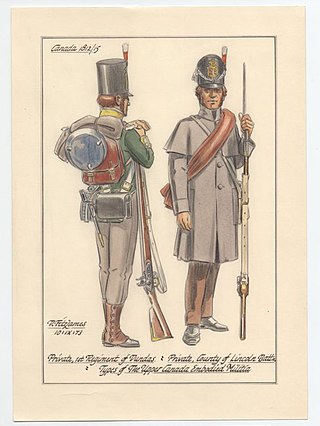
The Dundas County Militia was a regiment of the provincial militia of Upper Canada that was raised in Dundas County, Ontario, in the 1780s. The battle honours and legacy of the Dundas Militia are perpetuated by the Stormont, Dundas and Glengarry Highlanders.
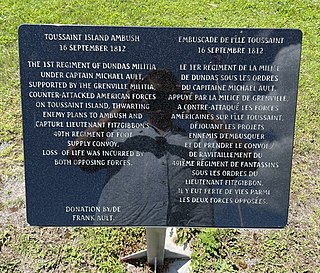
The Battle of Matilda, also known as the Battle of Toussaint's Island, was an early skirmish of the War of 1812 fought on September 16, 1812 between American and Canadian militia in the St. Lawrence River near the township of Matilda, in Dundas County.
On July 5, 1813, 34 Canadian militia and 7 British regulars from the 49th Regiment of Foot crossed the Niagara River and raided Fort Schlosser. They took the American garrison of 11 by surprise and captured them along with all the arms and stores.
The Skirmish at McCrae's House was a small skirmish fought on December 15, 1813, during the War of 1812 near Chatham, Ontario, Canada.
The Middlesex Militia was a regiment of the provincial militia of Upper Canada that was raised in Middlesex County, Ontario, in the early 1800s. The Middlesex Militia is currently perpetuated by the 4th Battalion, Royal Canadian Regiment.
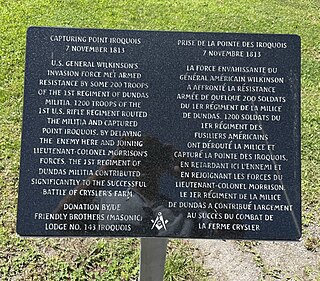
The Battle of Point Iroquois was a small skirmish fought on the morning of November 8, 1813, as part of Wilkinson's advance up the St. Lawrence towards Montreal. The skirmish occurred on the shores of the St. Lawrence River at Point Iroquois, Dundas County, where the river reached its narrowest point, only 500 yards across.










